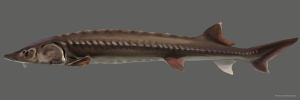Alex Hubberstey, Blue Marine Foundation’s (BLUE) UK Sturgeon Coordinator, spent two weeks on a canoe on the Severn, Wye and Tywi rivers searching for the ever-elusive European Sturgeon – known affectionately as the ‘dinosaur fish’. Sturgeon numbers have declined rapidly in Great Britain over the past two centuries and they have all but disappeared. BLUE and the UK Sturgeon Alliance is working to reverse this decline. This is Alex’s story…
I have always been in awe of the River Severn. I’d studied it on a screen but, until now, never actually experienced it in person. The setting sun casting an amber hue on the surface. The endless possibilities just beneath the water, hidden from view.
After months stuck at home we were finally out in the field, searching for European Sturgeon. The plan was to sample sites on the Rivers Severn, Wye and Tywi over a two-week period to see if there was accessible spawning habitat; well-oxygenated water, with clean gravel at least two metres deep – perfect for the elusive dinosaur fish.

European Sturgeon illustration by Dominique Vassie.
As we began canoeing on the first day, I once again pinched myself that this was my job. The upstream portion of the river was breath-taking. A wide expanse of river, broken up by large meanders and gravel islands, with House martins skimming the surface, cuckoos hiding among the willow scrub, and rather peculiarly, a fox who swam, bank to bank, in front of us. It was easy to imagine sturgeon just below the surface, hidden from sight.

Alex Hubberstey (left) and his team ready to launch.
Day two was a different story. We began by visiting some of the weirs and fish passes the Unlocking the Severn project had recently completed. Weirs are large wall-like structures aimed at raising water levels upstream, for milling or navigation. Having studied their effects, I can only see them as impenetrable barriers of concrete.
To migratory fish, a weir is the end of the line. European Sturgeon are not agile, they do not leap out the water, they cruise along the bottom. Weirs may as well be the Niagara Falls. Imagine someone putting a giant wall in the middle of the road to your house with no means of getting past. Migratory fish populations have declined by over 90 per cent in Europe, in part due to barriers removing access to critical habitats. In my own local river, the Ribble, most of the weirs have been removed or bypassed (one of them actually collapsed in the Boxing Day floods of 2012). Since then, there has been a noticeable increase in fish populations.

A weir is impenetrable to Sturgeon.
On a “normal” section of the Severn we found barely any flow, the channel was highly modified; straightened to speed up water getting from source to sea. The water stank from pollution and stagnation. Mercifully, we got off the river much sooner that day.
The next day delivered to us Tewkesbury weir, the only one not being unlocked and our final Severn site. The channel that allowed shad to pass over – it was in fact a pleasant surprise to see four make their way over the channel while we were looking at it – was impassable for sturgeon. At least one species was recovering, but there is still massive potential for improvement in the Severn. It could be brimming with vast schools of migratory fish again.
Next was the first Wye site. After the past two days, I was feeling anxious. “Please let this river be suitable”, I thought. How best to describe the Wye? “A sturgeon river”. It was amazing. Cliffs towered over the river, raptors soaring above us. Kingfishers zipped past, streaks of turquoise. The spawning habitat was plentiful and no weirs in sight. The flow was strong in places, leading to us almost capsizing a few times – an occupational hazard.

A large meander – perfect for Sturgeon.
On our last river, the Tywi, we found large flowing meanders leading to U-turns in the river with vast islands of gravel and willow scrub. Red kites soared above and a curious otter came to have a look at us. Forgetting the SD card for the camera and waiting around on the bank while someone went to get it wasn’t too bad with such scenery. The habitat here was spot-on. Plenty of deep pools for resting next to spawning substrate. Again, no weirs.
On the final day, we ditched the canoe and went ashore to the beach (well, the estuary), searching for juvenile habitat. Juvenile sturgeon spend one-to-three years in estuaries feeding on benthic (bottom dwelling) organisms. As we walked towards the water, the sand was littered with millions of different shells. The water’s edge boiled with countless tiny shrimp, while crabs and flatfish darted about just below the surface, with the crabs taking a particular fancy to my toes! Our verdict on the Tywi: Perfect for restoration.
It is not hard to picture innumerable sturgeon migrating up rivers like these. They did so for thousands of years, we were just too efficient at destroying and altering their habitats. As I drove home, I was content. That optimistic feeling had returned. It is my job to help sturgeon return to our waters. I can now say with confidence that they do have a home in the UK, we just need to give them a little hand to get back here.


















